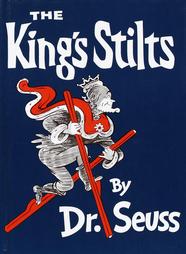Plot
The King's Stilts tells the story of King Birtram of Binn, who dedicates himself to safeguarding his kingdom, a low-lying land surrounded by high water that is held back by a ring of dike trees, who are the favorite food of a species of pest-birds called nizzards; the kingdom always faces the risk that the nizzards might compromise the dike-tree barrier and cause catastrophic flooding. The King's administration maintains a legion of Patrol Cats to keep the nizzards at bay; King Birtram sees to their care personally. When not attending to his royal duties, the King enjoys himself by frolicking in the streets on his red stilts, which most of his subjects note with amused acceptance.
One day, his minister Lord Droon, secretly a gloomy scoundrel who despises his King cavorting with such undignified happiness, plots to capture the stilts, persuading the King's page boy Eric to steal and hide the stilts. Deprived of his amusement, the King grows depressed and begins to neglect his duties. As a result, the Patrol Cats become less vigilant, and soon the nizzards make headway in eating away the dike trees. Seeing the results of his actions, Eric resolves to return the stilts to the King and succeeds in doing so despite Lord Droon's efforts to stop him. King Birtram, his personal morale restored, finds the energy to mobilize the Patrol Cats to fight off the nizzards and save the kingdom. Lord Droon is arrested and punished with a restricted diet consisting entirely of nizzard cooked in various ways. Eric is rewarded with his own pair of red stilts, and joins the King on his outings.
This page is based on this
Wikipedia article Text is available under the
CC BY-SA 4.0 license; additional terms may apply.
Images, videos and audio are available under their respective licenses.
